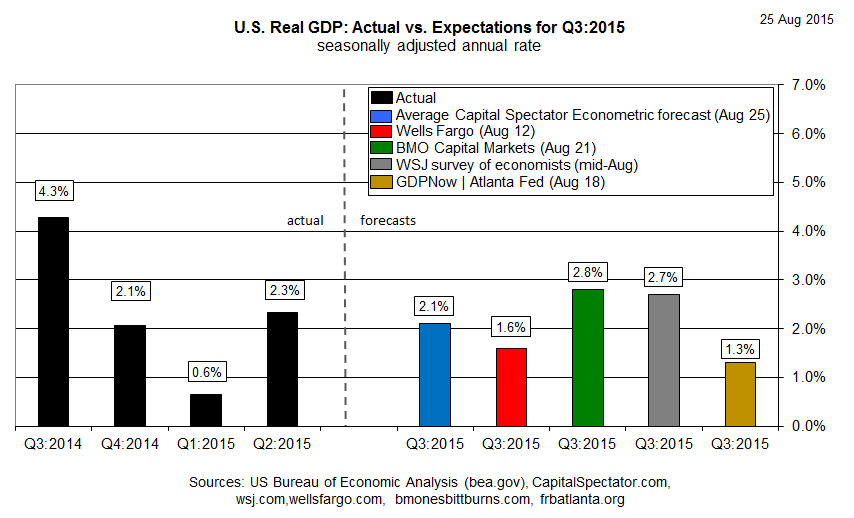Stock markets around the world have tumbled in recent days, which implies that expectations for economic growth have taken a hit. But markets aren’t flawless prediction machines and so it’s debatable if the current turmoil will lead to a contraction in global output vs. slower growth. If you’re a true optimist, you may be inclined to read the latest tantrum as noise, with little if any relevance for the real economy.
In any case, the near-term outlook for the US economy still points to a modest expansion, based on the available numbers to date. If that’s due to change for the worse, we’ll soon see the telltale signs in the incoming data. Meantime, US GDP for the third quarter is expected to increase 2.1% (seasonally adjusted annual rate), based on The Capital Spectator’s average estimate for several econometric forecasts. Today’s prediction represents a slight deceleration in the pace of growth relative to Q2’s 2.3% advance via the government’s July 30 report.
It’s still early for Q3 data and so much can (and probably will) change between now and October 29, when the US Bureau of Economic Analysis publishes its “advance” GDP estimate for the July-through-September period. Meantime, the spectrum of forecasts is relatively wide. Near the high end of expectations is BMO Capital’s recent prediction for a 2.8% rise in Q3 GDP (as of August 21). On the low end at the moment: the Atlanta Fed’s GDPNow model, which is currently anticipating a comparatively soft 1.3% increase in output for Q3 (August 18).
Here’s a summary of The Capital Spectator’s Q3:2015 average estimate vs. recent history and forecasts from various sources:

Here are the various forecasts that are used to calculate CapitalSpectator.com’s average estimate:

As updated estimates are published based on incoming economic data, the chart below tracks the changes in the evolution of The Capital Spectator’s projections.

Finally, here’s a brief profile for each of The Capital Spectator’s GDP forecast methodologies:
R-4: This estimate is based on a multiple regression in R of historical GDP data vs. quarterly changes for four key economic indicators: real personal consumption expenditures (or real retail sales for the current month until the PCE report is published), real personal income less government transfers, industrial production, and private non-farm payrolls. The model estimates the statistical relationships from the early 1970s to the present. The estimates are revised as new data is published.
R-10: This model also uses a multiple regression framework based on numbers dating to the early 1970s and updates the estimates as new data arrives. The methodology is identical to the 4-factor model above, except that R-10 uses additional factors—10 in all—to forecast GDP. In addition to the data quartet in the 4-factor model, the 10-factor forecast also incorporates the following six series: ISM Manufacturing PMI Composite Index, housing starts, initial jobless claims, the stock market (Wilshire 5000), crude oil prices (spot price for West Texas Intermediate) and the Treasury yield curve spread (10-year Note less 3-month T-bill).
ARIMA GDP: The econometric engine for this forecast is known as an autoregressive integrated moving average. This ARIMA model uses GDP’s history, dating from the early 1970s to the present, for anticipating the target quarter’s change. As the historical GDP data is revised, so too is the forecast, which is calculated in R via the “forecast” package, which optimizes the parameters based on the data set’s historical record.
ARIMA R-4: This model combines ARIMA estimates with regression analysis to project GDP data. The ARIMA R-4 model analyzes four historical data sets: real personal consumption expenditures, real personal income less government transfers, industrial production, and private non-farm payrolls. This model uses the historical relationships between those indicators and GDP for projections by filling in the missing data points in the current quarter with ARIMA estimates. As the indicators are updated, actual data replaces the ARIMA estimates and the forecast is recalculated.
VAR 4: This vector autoregression model uses four data series in search of interdependent relationships for estimating GDP. The historical data sets in the R-4 and ARIMA R-4 models noted above are also used in VAR-4, albeit with a different econometric engine. As new data is published, so too is the VAR-4 forecast. The data sets range from the early 1970s to the present, using the “vars” package in R to crunch the numbers.
ARIMA R-NIPA: The model uses an autoregressive integrated moving average to estimate future values of GDP based on the datasets of four primary categories of the national income and product accounts (NIPA): personal consumption expenditures, gross private domestic investment, net exports of goods and services, and government consumption expenditures and gross investment. The model uses historical data from the early 1970s to the present for anticipating the target quarter’s change. As the historical numbers are revised, so too is the estimate, which is calculated in R via the “forecast” package, which optimizes the parameters based on the data set’s historical record.
